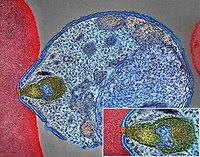
Photo from wikipedia
The conventional paper-based system for malaria surveillance is time-consuming, difficult to track and resource-intensive. Few digital platforms are in use but wide-scale deployment and acceptability remain to be seen. To… Click to show full abstract
The conventional paper-based system for malaria surveillance is time-consuming, difficult to track and resource-intensive. Few digital platforms are in use but wide-scale deployment and acceptability remain to be seen. To address this issue, we created a malaria surveillance mobile app that offers real-time data to stakeholders and establishes a centralised data repository. The MoSQuIT app was designed to collect data from the field and was integrated with a web-based platform for data integration and analysis. The MoSQuIT app was deployed on mobile phones of accredited social health activists (ASHA) working in international border villages in the northeast (NE) Indian states of Assam, Tripura and Arunachal Pradesh for 20 months in a phased manner. This paper shares the challenges and opportunities associated with the use of MoSQuIT for malaria surveillance. MoSQuIT employs the same data entry formats as the NVBDCP’s malaria surveillance programme. Using this app, a total of 8221 fever cases were recorded, which included 1192 (14.5%) cases of P. falciparum malaria, 280 (3.4%) cases of P. vivax malaria and 52 (0.6%) mixed infection cases. Depending on network availability, GPS coordinates of the fever cases were acquired by the app. The present study demonstrated that mobile-phone-based malaria surveillance facilitates the quick transmission of data from the field to decision makers. Geospatial tagging of cases helped with easy visualisation of the case distribution for the identification of malaria-prone areas and potential outbreaks, especially in hilly and remote regions of Northeast India. However, to achieve the full operational potential of the system, operational challenges have to be overcome.
Journal Title: International Journal of Environmental Research and Public Health
Year Published: 2022
Link to full text (if available)
Share on Social Media: Sign Up to like & get
recommendations!